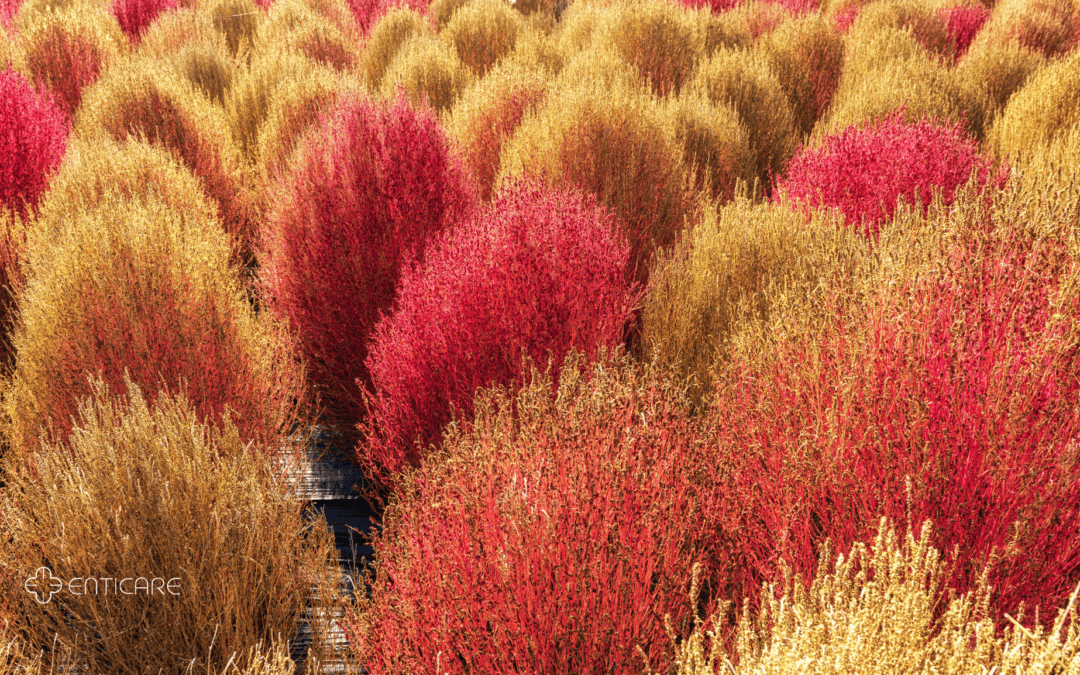Those feathery green or red bushes lining roads and fields might seem harmless, but for some, they’re a hidden allergy culprit. Kochia, also known as lamb’s quarter or Belvedere summer cypress, can trigger a wave of allergy symptoms if you’re sensitive to its pollen. Here’s to unmasking Kochia & Lamb’s Quarter Allergies.
Kochia is a unique plant native to Eurasia. It’s known for its soft, feathery foliage that transforms from green to vibrant shades of red and orange in the fall. While often used as an ornamental plant, kochia can also grow wild in many areas of North America, particularly in disturbed soils and wastelands.
Origin of Prickly Summer Annual Weed in North America
As mentioned previously, kochia is not native to North America. It’s believed to have been introduced in the 19th century, likely as a contaminant in crop seeds. Kochia is commonly found in crop fields and disturbed areas.
If you experience allergy symptoms in late summer and early fall, kochia pollen could be the reason. The plant releases pollen from August to October, coinciding with the peak allergy season for many.
Signs and Symptoms of Kochia Scoparia
If you have a Kochia allergy, you might experience these common symptoms during the plant’s pollen season:
- Runny or stuffy nose
- Itchy, watery eyes
- Sneezing
- Coughing
- Scratchy throat
- Headaches (in some cases)
- Difficulty breathing (in severe cases)
Causes and Early Growth Stages
Similar to other allergies, kochia allergies arise when your immune system mistakes harmless pollen for a threat. When you inhale kochia pollen, your immune system overreacts, releasing chemicals that trigger allergy symptoms.
Kochia Control and Prevention
Here are some tips to minimize your exposure to kochia pollen and manage allergy symptoms:
- Check daily pollen forecasts and limit outdoor activities when kochia pollen counts are high.
- Stay indoors during peak pollen hours: Mornings and evenings are generally the worst times for kochia allergies.
- Use air purifiers: Air purifiers with HEPA filters can help trap pollen indoors.
- Plan your commute: If possible, avoid routes with heavy kochia growth during peak pollen season.
- Manage kochia growth in your garden and fields to protect desirable plants from being damaged.
While anyone can develop a kochia allergy, certain factors can increase your risk:
- Family history of allergies: If you have a family history of allergies, you’re more likely to develop allergies yourself, including kochia.
- History of hay fever: People with hay fever are more prone to develop allergies to other airborne allergens like kochia pollen.
- Asthma: Kochia pollen can worsen asthma symptoms.
There’s no cure for kochia allergy, but several treatment options can manage your symptoms and improve your quality of life:
- Over-the-counter medications: Antihistamines can help alleviate allergy symptoms like itchy eyes, runny nose, and sneezing. Decongestants can help clear nasal congestion.
- : These prescription medications can effectively reduce inflammation in the nasal passages, offering long-term relief.
- Allergy shots (immunotherapy): This long-term treatment involves gradually increasing your exposure to kochia pollen over time, desensitizing your immune system and reducing your reaction to the allergen.
Living with kochia allergies can be manageable with awareness and proper strategies. By following these tips and consulting with a healthcare professional, you can minimize your exposure to kochia pollen and enjoy the outdoors comfortably. Invest in Your Well-being. Explore Enticare’s Range of Treatments. Call 480-214-9000!

